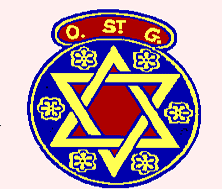
THE CLUB BADGE.
Explanation: Dark blue for Oxford University, Red for St. George, Tudor roses for England and a Star of David for Judaism. And the club aimed to follow the ideals of all four.
|
THE OXFORD AND ST. GEORGE'S CLUBS.
 |
Gaffer & Missus
at camp. 1926 |
In the early part of the 20th century The East End of London was densely packed with Jews. Some streets had 95 to 100% Jewish occupancy. Most of these were recent immigrants from Russia and Poland who had come to escape the anti-Semitism and the pogroms there. Living conditions were appalling. Families were crowded together in bad quality housing, without a bath or an inside toilet. Some racist politicians spoke of "The Jewish Problem", accusing the Jews of taking jobs and housing from native-born Englishmen and also of creating a crime wave. The Jews were accused of being alien because they spoke Yiddish and because they had peculiar customs.
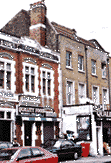 |
125 Canon
Street Road |
One person who helped to change the situation was a young man called Basil Henriques, who came down from Oxford University and founded a boys club in premises in Cannon Street Road. The club was called Oxford and St George's, and opened in 1914, a few months before the start of the 1st World War. (Oxford from the university and St George's from the area of East London where the club was situated.) In 1915 Rose Loewe started a parallel girls club.
BETTS STREET.
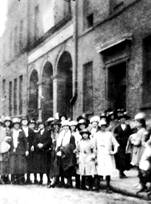 |
Club girls outside
Bett Street premises 1919. |
Basil and Rose married in 1917. Captain Basil Henriques returned from the war after a distinguished career in the Tank Corps, where he commanded one of the first tanks ever to engage in battle. In 1919 Basil and Rose Henriques started the St Georges Jewish Settlement in Betts Street. They lived on the premises and ran the clubs there. They were affectionately known as The Gaffer and The Missus.
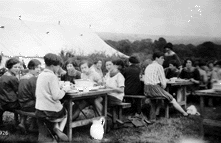 |
| Meal time at camp 1926. |
The clubs were not just social. They were educational, and taught sports, acting, ballet, physical education, First Aid, etc. They helped to prepare the boys and girls to enter into the British way of life and so helped them in eventually seeking careers. At the same time they gave them a modern outlook upon Judaism and their Jewish heritage. The highlight of the year was the Annual Summer Camps. The clubs took several hundred Jewish children away for a holiday under canvas each year. For many youngsters this was the only time that they left inner city London. Many of these annual camps were at Highdown near Goring by Sea. The boys and the girls went to separate camps. These camps were enjoyed so much that the old boys continued going to camps for many years after they had grown up. In fact, some of the Old Boys and Girls still (in 2007) have an annual holiday together, although they call it camp, it is now in an hotel.
BERNERS STREET.
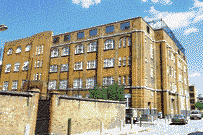 |
| Berner Street |
In 1929 the clubs moved to a large building in Berners Street. A cigarette manufacturer named Bernhard Baron donated money for the purchase of an old school building. The flat roof was converted into a play area with netting over the top so that ball games could be played. (This is still visible in the accompanying picture; but since the conversion to luxury flats it has been removed.) There was a well-equipped gym and many other facilities. The building was known as the Bernhard Baron Settlement. As a settlement, it catered for Jewish needs from the cradle to the grave. It had a clinic for expectant mothers and other patients, a toddlers Group, youth clubs, Young Marrieds Organisation, parents groups, Friendship Club and luncheon club for the elderly. Also there was a diabetes Clinic and first aid centre. And the Settlement Synagogue had religion classes, adult activities and a burial scheme. In between there was a Boot Club, which helped to provide footwear for children in families who could not afford it, and there was a Poor Man's Lawyer scheme where people could get free legal advice and was a forerunner of the Citizens Advice Bureaux. During world war 2 it housed an Air Raid Wardens post.
The club was particularly renowned for its sporting successes. The clubs had teams for Cricket, Football, Netball and Hockey. They entered Swimming, PT, Table Tennis and Boxing competitions and gave coaching in all of these. They produced several boxers who gained titles like Harry Mizler and Kid Berg. (The well equipped shower room proved to be an attraction for youngsters who otherwise had to go either to the public baths or bathe in a tin bath in their living room.) The clubs succeeded in creating a tremendous club spirit, which lasted long after their youth. They had their own club cry based upon a Maori chant. "Boomalaka." (WAV File 426 Kb, 20 seconds. playing time)
WORLD WAR 2.
During the 2nd World War 600 old boys and girls served in the British forces. The Gaffer used to keep in touch with all of them and later published a book of some of this correspondence. On Friday nights the Gaffer and the Missus took the choir into the Tilbury air raid shelter to conduct Sabbath evening services. Basil Henriques became a magistrate specialising in juvenile cases and eventually received a knighthood. The Gaffer died in 1961. He was a most impressive figure being 6 foot 4 inches tall. His wife was very short, but with a very strong personality. She was artistic and played both the piano and the organ. She produced a Club Song Book which contained 176 songs where she had written new words set to old tunes.
To hear a sample song which tells of the beginning of the Girl's Club you can hear two verses of "The 18th of July" WAV file 1.13 Mb, 53 secs. The tune is "Coming Through the Rye".
The clubs were very successful in teaching the young generation how to get on in the world and it instilled in them an ambition to better themselves. By doing this it helped in its own demise. One result was that many Jews left the crowded insanitary conditions of the East End, to live and work in more prosperous areas. Eventually, in 1973, the Bernhard Baron Settlement was sold and the clubs moved to Totteridge in North London.
RETURN to HOME PAGE





